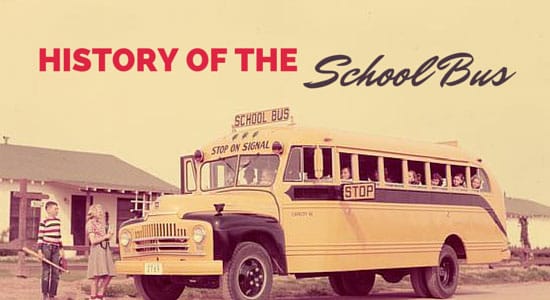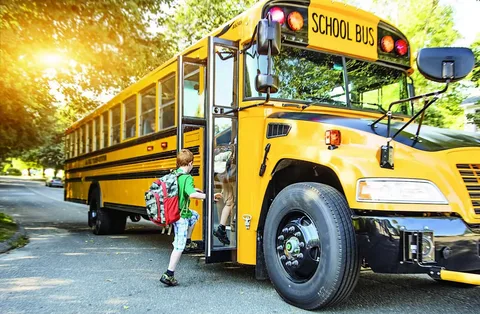School Bus History
I know this may be a bit at length, but I feel that a bit of history on what we do is needed. Gracious thanks to Wikipedia for allowing this to be used on this site. If you want to see historical pictures, please feel free to go to the Old Photos Page.
A school bus or school omnibus is a bus used to transport children and adolescents to and from school. The first school bus was horse-drawn, introduced in 1827 by George Shillibeer for a Quaker school at Abney Park in Stoke Newington, London, United Kingdom and was designed to carry 25 children.
The bus has subsequently become a major mode of transportation, particularly for transporting children to school. Children may travel to school on regular public bus services. In some cases public bus services may run field trips and high school athletic events, and private coach services may put on their own paid services. In North America, however, the school bus is itself a specific type of bus distinct from other buses. Canada and the United States have specially built, painted and equipped school buses. They are commonly painted a “yellow-orange” color (officially known as “National School Bus Chrome Yellow”) for purposes of visibility and safety and equipped with specialized traffic warning devices, with the exception of school activity buses (normally used exclusively for point-to-point field and athletic trips and not used for home delivery routes) which are built to the same standards but are customarily some color other than orange and are usually not equipped with traffic warning devices. Most purchased in recent years have been diesel-powered or hybrid. Full-size school buses can seat 59 to 90 passengers, but in many districts smaller vehicles are used as well. Such smaller vehicles are commonly known as “short buses”, and are often used for low-density routes associated with private schools and programs for magnet programs and developmentally-challenged students.
Most U.S. school districts purchase the buses and hire their own drivers, while others engage the service of school bus contractors such as Laidlaw to perform this function. School bus services in the UK in almost all cases are contracted out to local bus companies. Elsewhere in Europe school bus services are contracted to local bus companies, which use regional buses that operate on regular lines at other times, or in some cases older regional buses.
Early Modes: Wagons & Kid Hacks
Wayne Works, predecessor of Wayne Corporation, was founded in the United States of America in 1837. By 1886, and possibly earlier, it is known that the company was making horse-drawn school carriages which many people referred to as “school hacks,” “school cars,” “school trucks,” or “kid hacks.” (“hack” was a term for certain types of horse-drawn carriages.) In this era, in rural areas, it was very common to use farm wagons to transport children to schools throughout North America, with regional adaptations such as sleds in extreme northern climates.
Motorized Vehicles, Early School Buses
In 1914, Wayne Works dropped a wooden kid hack onto an automobile chassis, creating a predecessor to the modern motor school bus. In the bodies for school transportation the company produced through this era, passengers sat on perimeter seating, facing the center rather than the front of the bus. Entry and egress was through a door at the rear, a design begun in non-motorized days so as not to startle the horses. This was possibly a precursor to the rear emergency door commonly found on modern school buses.
In 1927, Blue Bird Body Company and Wayne Works began building all-steel bus bodies In 1932, Gillig Bros. built their first school bus, which was an all-steel unit and by the mid 1930s, nearly every school bus manufacturer was using steel over wood or other materials for body construction. In the 1930s, many school bus manufacturers also began installing additional exterior “rails” along the length of their buses to add structural rigidity and to aid in passenger protection. Known as either crash, rub, or guard rails, Wayne Works was the first known manufacturer to utilize them in bus construction.
Early school buses primarily served rural areas where it was deemed impractical for the young students to walk the distances necessary to get back and forth from school on their own, and were sometimes no more than a truck with perhaps a tarpaulin stretched over the truck bed.
Wayne Works was one of the earliest school bus companies to offer glass in place of the standard canvas curtains in the passenger area long before many “school” bus companies did in the early 1930s, although it was Gillig Bros, who had invented and patented the design long before. Known as the “California top”, the design featured a slightly curved reinforced metal roof, with windows separated by pillars at regular intervals, and each window was adjustable by the use of a latching mechanism.

School children boarding school bus in the 1940’s
Transit Style School Buses
In the 1930s, Wayne Works, Crown Coach, Gillig Bros., and other school bus body companies manufactured some transit-style school buses, that is, types with a more or less flat front-end design (known in modern times as “type D” school buses). Crown Coach built the first heavy duty, high capacity, transit style school coach in 1932 and named it the “Supercoach”, as many California school districts operated in terrain requiring heavy duty vehicles. Another factor in the rapid rise in transit-style school bus sales in the 1950s, especially on the West Coast, was the “Baby Boom” generation. School districts were faced with a rapid rise in student counts and were forced to consolidate, buy larger school buses, or both. As a result, the use of the transit style school bus skyrocketed during the mid 1950s. In 1959, Gillig Bros. introduced the very first rear-engine diesel-powered school bus. The C-180 Transit Coach soon afterwards became the most popular rear-engine transit-style school bus on the west coast.
In 1950, Albert L. Luce, founder of the Blue Bird Body Company, developed a transit style design which evolved into the Blue Bird All-American, generally considered the first successful east coast school bus transit design. However, the “conventional” design, with a truck type hood and front-end (known as type C on modern school buses) was to continue to dominate US school bus manufacturing through the end of the 20th century.
Dr. Frank W. Cyr: Father Of The Yellow School Bus
Most school buses turned the now-familiar yellow color beginning in 1939. In April of that year, Dr. Frank W. Cyr, a professor at Teachers College at Columbia University in New York organized a conference that established national school bus construction standards, including the standard color of yellow for the school bus. It became known officially as “National School Bus Chrome,” later renamed “National School Bus Glossy Yellow.” The color, which has come to be frequently called simply “school bus yellow”, was selected because black lettering on that hue was easiest to see in the semi-darkness of early morning and late afternoon.
The conference met for seven days and the attendees created a total of 45 standards, including specifications regarding body length, ceiling height, and aisle width. Dr. Cyr’s conference, funded by a US $5,000 grant from the Rockefeller Foundation, was also a landmark event inasmuch as it included transportation officials from each of the then 48 states, as well as specialists from school bus manufacturing and paint companies. The conference approach to school bus safety, as well as the yellow color, has endured into the 21st century.
Growth in School Bus Use After World War II
Following World War II, there were movements in Canada and the U.S. to consolidate public schools into fewer and larger ones, leading to an increase in demand for school buses. Rapid urban growth also outpaced school construction; coupled with the population expansion brought on by the baby boomers themselves having children, the need for busing within large urban centres in North America became acute.
United States Safety Issues…
Protecting School Children Loading And Unloading
By the mid 1940s, most states had traffic laws requiring motorists to stop for school buses while children were loading or unloading.The justifications for this protocol were that:
Children, especially the younger ones, have normally not yet developed the mental capacity to fully embrace the danger and consequences of crossing safety without adult supervision. Under U.S. tort laws, a child cannot legally be held accountable for negligence for this reason. For that same reason, adult crossing guards often are deployed in walking zones between homes and schools.
It is impractical in many cases to avoid children crossing the traveled portions of roadways after leaving a school bus or to have an adult accompany them.
The size of a school bus generally limits visibility for both the children and motorists during loading and unloading.
Warning Lights And Safety Devices
School bus safety officials were aware that many accidents occurred when traffic was not aware that the hazard existed, and children on foot were hit by other vehicles. The standardized yellow color helped and warning lettering was painted in large letters on school buses. Several devices were developed to help school bus drivers warn other motorists.
Around 1946, one of the early (and possibly the first) systems of alternating traffic warning lights on school buses was used in Virginia. In those days before the advent of transistors and advanced plastic lens technology, an alternating system was created by using sealed beam headlight bulbs with the lenses colored red, and a mechanical motor and solenoids to alternate the high and low beam filaments in the single bulb fixtures mounted at the front and rear of the bus. School children and drivers were subjected to a loud tick-tock noise from the flasher motor as it was operating. Activation was typically through a mechanical switch attached to the door control. However, on some buses such as Gillig’s Transit Coach models and the Kenworth-Pacific School Coach, activation of the roof warning lamp system was through the use of a pressure sensitive switch on a manually-controlled stop paddle lever located to the left of the driver’s seat below the window. Whenever the pressure was relieved by extending the stop paddle, the electrical current was activated to the relay.
Around this time, some states began specifying a mechanical stop arm (some state specifications, such as Washington state refer to the device as a “stop paddle”, due to its resemblance to a large paddle) which the driver could activate to swing out from the left side of the bus to warn traffic. The portion of the stop arm protruding in front of traffic initially started out as a rectangle with “STOP” painted on it, and in the late 1960s the rectangle shape was replaced by an octagon-shaped sign bearing a typical stop sign, with “STOP” applied to both sides.
In later years, flashing lights were added to the stop arms, mechanical flasher devices were replaced by electronic ones, and the front and rear warning lights were increased from two to four and eventually eight (in most states; Wisconsin still does not allow the use of a full 8-way roof warning flasher system). Plastic lenses were developed in the 1950s which offered greater visibility and significantly lower costs than the early systems which used colored headlight bulbs, although manufacturers such as Gillig and Crown Coach Corporation were still using the sealed-beam glass bulb design until well into the 1980s and early 1990s.
Many school districts are purchasing buses with two stop arms, the additional one located on the left side near the rear of the bus, for extra safety.

A example of the stop sign mounted on the buses drivers side. Some buses have them on the back also.
Structural Integrity
As the school bus evolved in the United States and Canada as a specialized vehicle, there became concerns for the protection of the school children during major impacts. A weak point and location of structural failure in catastrophic school bus crashes was well-known to be joints, the points where panels and pieces were fastened together.
Longitudinal steel guard rails had been in use since the 1930s to protect the sides of buses, but behind them on the sides and on the roofs, by the 1960s, all manufacturers were combining many individual steel panels to construct a bus body. These were usually attached by rivets or similar fasteners such as huckbolts.
Around 1967, Ward Body Company of Conway, Arkansas subjected one of their school bus bodies to multiple roll, and noted the separation at the joints, as well as pointing out that many of their competitors were using far fewer rivets. This resulted in new attention by all the body companies to the number and quality of fasteners.
Simply increasing the number of fasteners (rivets, screws, and huckbolts) was not enough to satisfy engineers at Wayne Corporation in Richmond, Indiana. In their tests, no matter how many fasteners were used, the joints were always the weak point under high stress loads. They also noted how the continuous guard rails used on the sides tended to spread the stress from a point of impact, allowing it to be shared and dissipated at portions of the body structure further away.
Instead of trying to figure out how to make the fasteners do a better job, they stood back and wondered if the design features of the guard rails could be expanded. The result was a revolutionary new design in school bus construction: Continuous longitudinal interior and exterior panels for the sides and roofs.
Branded the Lifeguard, the new school bus design used Wayne’s huge roll-forming presses to make single steel pieces which extended the entire length of the bus body. The concept was that by reducing the number of joints, the number of places where the body could be anticipated to separate in a catastrophic impact was reduced in a like amount.
The “Lifeguard” design reduced overall body weight, the number of fasteners used, and man-hours required for assembly. However, it required the very large roll-form presses and special equipment to handle the panels. A more practical problem was the panels had to be cut to exact length for each bus body order, which varied with seating capacities and from state-to-state. This created a marketing assignment help as the Wayne factory required greater manufacturing lead time than when parts were more interchangeable between orders under older panel technology.
In the years after Wayne introduced the Lifeguard design in the 1973 model year, competing body manufacturers began moving towards using fewer side panels and joints, although none went as far as Wayne in the 1970s.
Federal Standards For School Buses
The focus on structural integrity resulted in the joint requirements of the U.S. Federal Motor Vehicle Safety Standards for school buses, most of which became applicable for school buses on April 1, 1977. The following, including Standard 221 (joint strength) are generally considered to be the most important, even thirty years later.
Standard No. 217 – Bus Emergency Exits and Window Retention and Release (Effective September 1, 1973) This standard establishes minimum requirements for bus window retention and release to reduce the likelihood of passenger ejection in crashes; and for emergency exits to facilitate passenger exit in emergencies. It also requires that each school bus have an interlock system which will prevent the engine from starting if an emergency door is locked and an audible warning system which will sound an alarm if an emergency door release mechanism is not closed while the engine is running.
Standard No. 220 – School Bus Rollover Protection (Effective April 1, 1977) This standard establishes performance requirements for school bus rollover protection. The purpose of this standard is to reduce the number of deaths and the severity of injuries that result from failure of the school bus body structure to withstand forces encountered in rollover crashes.
Standard No. 221 – School Bus Body Joint Strength (Effective April 1, 1977) This standard establishes requirements for the strength of the body panel joints in school bus bodies. The purpose of this standard is to reduce deaths and injuries resulting from the structural collapse of school bus bodies during crashes.
Standard No. 222 – School Bus Passenger Seating and Crash Protection (Effective April 1, 1977) This standard establishes occupant protection requirements for school bus passenger seating and restraining barriers. The purpose of this standard is to reduce the number of deaths and the severity of injuries that result from the impact of school bus occupants against structures within the vehicle during crashes and sudden driving maneuvers.
Standard No. 301 – Fuel System Integrity – School Buses (Effective April 1, 1977) This standard specifies requirements for the integrity of motor vehicle fuel systems. Its purpose is to reduce deaths and injuries occurring from fires that may result from fuel spillage during and after motor vehicle crashes.
Continuing Safety Efforts Since 1977
The new Federal Standards of 1977 for school buses represented a quantum leap in school bus safety. Other efforts and innovations were to continue.
More sophisticated and comprehensive mirror systems were developed to help drivers see children who were off the bus at almost all times.
Crossing gates were developed to help children avoid walking in the area immediately in front of the bus.
Reflective striping, LED and strobe lights were added in the 1980s and 1990s.
Modern school buses are often well equipped with amenities lacking only a few years ago such as air conditioning, two-way radios, high headroom roofs (Gillig and Crown Coach were producing high-headroom school buses as early as the mid 1950s) and wheelchair lifts (typically those with lifts are shorter than their counterparts and are sometimes exclusively assigned to carry disabled children).
Video cameras and recorders have become common equipment installed inside school buses, primarily to monitor (and record) behavior of the passengers. However, on March 28, 2000, a Murray County, Georgia, school bus was involved in a wreck with a CSX freight train at an unsignalled grade crossing, killing 3 children. Although the school bus driver claimed to have stopped and looked for approaching trains before proceeding across the tracks, the onboard camera clearly recorded that the bus had not stopped as it approached the tracks prior to the collision.
Seat Belts In School Buses
Compartmentalization was introduced in 1967, setting the ideal seat back height at 28 inches (although most seat heights are now 24 inches tall).The premise was that surrounding passengers with cushioning to the front and behind provide effective constraint in the event of a collision.
Although not an element of compartmentalization, the UCLA researchers who conducted the 1967 tests on school buses concluded that after high back seats, next in importance to school bus passenger collision safety is the “use of a three-point belt, a lap belt or other form of effective restraint.”
Very few school buses have seat belts, a standard safety feature in cars and light duty passenger vehicles. In 1977, as provided in Standard 222, the federal government required passive restraint and structural integrity standards for school buses in lieu of requiring lap seat belts. In the 1980s, some districts in the US tried installing lap belts and then later removed them, claiming operational and passenger behavior problems. Whether lap belts should be required remains very controversial, although they are now required in at least 4 states (New York, New Jersey, California and Florida).School buses in Texas will be required to be equipped with seat belts by 2010/2011.
However, only one state, New Jersey, requires seat belt usage.In other states it is up to the district whether to use seat belts or not.
Pollution
Generally, a school bus is a pollution-reducing alternative to individual parents driving children to and from school, even when carpooling is taken into consideration. The use of a single school bus can take as many as fifty private cars off the road. However, buses are not a pollution-free alternative, like biking or walking. Since most school buses burn diesel, the amount of pollution emitted has been a concern for some people. Many school buses sit at idle while waiting for passengers at a pickup stop or school. Most are also sitting at idle while children are on- and off-loaded.
The exposure of young children and teenagers to large amounts of diesel fumes daily for a long period of time (over ten years) has led to clean diesel requirements for new school buses in some places. However, some school district fleets include a few school buses which are over 30 years old.
As a result, diesel electric hybrid, compressed natural gas, and hydrogen powered school buses have been developed. Some buses have been retrofitted with emission control technologies and particulate matter filters, while others are being replaced.
Fuel Costs
The rise in fuel costs after Hurricane Katrina resulted in many school boards running deficits. Fuel costs are the largest variable in a school board’s budget, and are now also their greatest concern.
As a result, many school districts are looking to purchase diesel electric hybrid buses. Regenerative braking on these buses also reduces the number of brake replacements and labor costs of maintenance.
Diesel Electric Hybrids
IC Corporation, in collaboration with Enova Systems, unveiled the nation’s first hybrid school bus in 2006 at the New York Association of Pupil Transportation (NYAPT) Show. The hybrid school bus is expected to attain a 40 percent increase in fuel efficiency, which becomes even more essential with the rising fuel costs affecting many school districts. Lower maintenance costs are also expected.
Eleven states have joined together for an exploratory purchase of 19 school buses from IC Corporation. New York, California, Texas, Florida, Pennsylvania, Virginia, North Carolina, South Carolina, Arkansas, Iowa and Washington will be the first states in the nation to receive these diesel electric hybrid school buses.
Currently, 16 of the buses are fully funded and International Truck and Engine Corporation has started production on the ordered buses for delivery in late spring 2007.
School Busing For Racial Purposes
During the era of segregation in the United States, school buses were often used to transport Black students to all-black schools, which were often further away from their homes than other public schools designated for white students. Sometimes, these were in only one or two locations within an entire county or other school district.
After the United States Supreme Court ruled in the case of Brown v. Board of Education in 1954 that school and other segregation was an unconstitutional violation of rights granted to all citizens under the Fourteenth Amendment, some districts either voluntarily or by court order introduced new pupil assignment plans to promote racial desegregation. School districts in such situations were spread across virtually the entire United States, including those of many cities such as Los Angeles, California, Boston, Massachusetts, Wichita, Kansas, Cleveland, Ohio, and Norfolk, Virginia.
The desegregation plans usually resulted in more pupils of all races assigned to schools further from their homes than before. School buses (and city transit buses in some instances) were often used to transport the students reassigned to different schools beyond a reasonable walking distance. Opponents of this concept began to decry the practice as “forced busing”.
In cities such as Richmond, Virginia, when a massive program began in 1971, parents of all races complained about the long rides, hardships with transportation for extra-curricular activities, and the separation of siblings when elementary schools at opposite sides of the city were “paired,” (i.e. splitting lower and upper elementary grades into separate schools).
In an effort to satisfy parents concerned about mandated long bus rides, many districts such as Richmond later modified their pupil placement plans to provide attractive programs in “magnet schools”, and built new school buildings and reconfigured older buildings to develop logistically more favorable attendance plans which met desegregation goals. Combined with changes in housing patterns, the forced busing programs were gradually eliminated as the courts nationwide released districts from orders under old lawsuits.
Today, school buses are still used in most of these districts, but this is much more due to reduced walking zones, concern for pupil safety, and a wider choice of programs and locations for many students.
Retired School Buses
When a school bus is retired from school transportation in the United States, most states have requirements that school bus lettering must be covered or removed and warning devices deactivated or removed.At least one state prohibits non-school buses from being more than 50% yellow, reserving the color on buses for school buses only. Regulations vary from state to state. Adversely, depending on state regulations, school buses may also retain their warning devices and lettering (for which usually just the “SCHOOL BUS roof lettering is allowed to remain) after retirement shall the new owner decide to restore it to factory-new condition.
The large quantity of school buses retired from daily service has helped develop a wide range of uses for them.
Although a new school bus commands a very high price, around $65,000-$110,000, a used school bus will often sell for far less than what was initially paid. Due to the very high depreciation of a used school bus, it is not uncommon to see used school buses sell for $500-$2500 at surplus auctions, and around $3000-$5000 on the used bus sales markets. These prices give the opportunity for an ordinary person to purchase a bus.
Many retired school buses are later sold to churches and used to transport elderly and mobility-impaired worshippers to and from church services or to transport youth groups for outings to amusement parks, picnics, and visiting other churches.
Some used school buses are shipped to Latin America and occasionally Africa for use as municipal transportation, transportation of migrant farmworkers, or even rededicated to pupil transport. This includes Cuba, which, in spite of the US embargo, imports them from Canada.
In some cases, after a school bus has been removed from regular service, it may be used as a substitute for newer buses that have broken down, or been removed from regular service for maintenance. These buses are still, in all aspects completely safe, but they usually lack the features of newer buses including air conditioning and tinted windows. After a certain amount of time has elapsed however, even substitute buses are completely retired and may be used for the aforementioned purposes.
Retired school buses have also been converted to motor homes and recreational vehicles. Enthusiasts of this type of vehicle conversion are sometimes called Skoolies.
Some retired school buses also get purchased for the purpose of total restoration, back to a “factory-new” condition. The individual who purchases and then restores a school bus is known as a “school bus enthusiast.” Some school bus enthusiasts also become school bus collectors, and a select few open up websites devoted to their hobby.
1980-2000: Industry Consolidation, Fallen Flags.
In 1980, in the U.S., there were six major school bus body companies building large school buses, mostly making bodies for chassis from four truck manufacturers, joined by two coach-type school bus builders on the West Coast. With the baby boom years which swelled the ranks of school children in the past, the manufacturing industry faced serious over-capacity as companies vied and competed for lower volumes of purchases by school bus contractors, school districts, and several states which purchase their buses in quantity at the state level.
On the West Coast, Crown Coach closed its doors in Chino, California in March of 1991. The property buildings are completely gone, leaving a unwanted and very dirty piece of land. GE, who still does own the rights to Crown, can’t sell it. Product rights and tooling were sold to Carpenter, and resulted in some Crown-by-Carpenter products in the 1990s. The other builder, Gillig Bros. (by then just simply known as the Gillig Corporation), dropped school bus production, but successfully developed a transit bus market to replace it, and remained in business. By mid 2000, there were only three body builders left, and a corporate consolidation of two of those with truck manufacturers reduced the model selection further.
Ward later became Amtran, and then was purchased by International Truck. They refused to sell chassis to other body manufacturers or inflated price so high that there were no options for body builders but to merge or go out of business.
Several new small bus manufacturers developed niche markets during this period. However, despite several notable attempts at revival, long-term body company industry names such as Superior, Ward, Wayne, Carpenter, and Crown-by-Carpenter all became fallen flags (in that order).
Wayne’s inventory was purchased by Carpenter and some of their parts were obviously used on the Crown By Carpenter buses. A defect in the roof welds was later found on all buses manufactured after 1994. A lot of school systems were forced to retire buses early and Carpenter had been out of business for sometime leaving districts no recourse.
Current School Bus Manufacturers
Blue Bird Corporation successor to Blue Bird Body Company.
Collins Bus, which purchased formerly independent Mid Bus in 1998 and rights to Corbeil Buses in 2007, with plans announced in to consolidate all manufacturing at Collins facility in Kansas as of September 19, 2007.
IC Corporation part of Navistar and successor to International Harvester, Ward Body and AmTran.
Thomas Built Buses, Inc. successor to Perley A Thomas Car Works. Now owned by Diamler/Chrysler.










